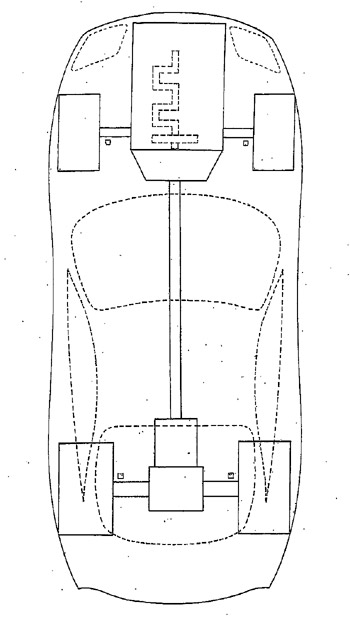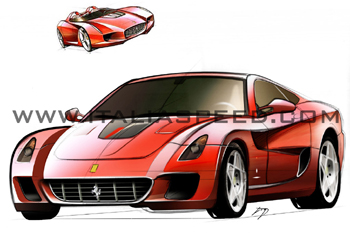|
Ferrari are currently developing an innovative new adaptive four-wheel drive system.
Its introduction date is as yet unknown, but it may become available as an option on future front-engined
models, including the forthcoming Ferrari 575 Maranello replacement
(codename F139), the facelifted Ferrari 612 Scaglietti, as
well as future Maserati and Alfa Romeo models.
Ferrari claims that the traditional rear-wheel drive layout
with self-locking differential has advantages over
four-wheel drive systems under high speed driving in dry or
acceptably wet road-holding conditions. When combined with
high power engines, and oversized tyres, however, rear-wheel
drive offers less optimum characteristics in poor
road-holding conditions, such flooding or ice. To make
driving easier in lesser road-holding conditions, high performance sports cars can be equipped with either a permanent or a connectable four-wheel drive system.
A permanent four-wheel drive arrangement greatly improves vehicle performance in poor road-holding conditions, but has the drawbacks of permanently increasing torque loss in the drive system, and
thus imposing a characteristic which drivers do not always find suitable in good road-holding conditions.
By contrast, a connectable four-wheel drive system allows for the
sports car's driver to choose between rear-drive in when in good road-holding conditions and four-wheel drive
when faced with poor road-holding conditions.
Connectable four-wheel drive systems are complex, however,
and therefore very expensive to produce. Moreover, drivers
may not observe patches of ice on the road, and so fail to connect the four-wheel drive in time.
Ferrari has recently designed a new connectable four-wheel drive system, which is both cheap and easy to produce, as well as being free of the disadvantages mentioned above. Under normal driving circumstances, the drive system resembles that of a regular Ferrari 612 Scaglietti, where drive torque is provided to the rear wheels by means of a transaxle.
|
 |
|
This drawing shows the basic elements of Ferrari's connectable four-wheel drive system. Unlike
traditional systems, the torque to the front wheels is not supplied through the same gearbox as used for the rear wheels, but by means of an oil-bath clutch. |
|
|

 |
|
The new connectable four-wheel drive system might become available on the Ferrari 575 M
replacement, codenamed "F139", at a later stage, as well as on other transaxle models including
Maserati and Alfa Romeo models |
|
|
Sensors at the front and rear of the car constantly measure the angular velocity of the wheels, which is processed to detect deviations which indicates skidding. As soon as skidding is detected, the connectable four-wheel drive system comes into play.
Torque is provided to the front wheels by means of an oil-bath clutch containing a number of disks integral with the propeller shaft, and alternating with an equal number of disks integral with the gear train. The oil-bath clutch operates in a fashion not dissimilar to a fluid flywheel. Between the engine output and the oil-batch clutch, a gear train with a constant velocity ratio is located. The constant velocity ratio is equal to that of the third gear in the transaxle, as this is a gear where fast driving and skidding is likely to occur. When third gear is engaged, the input and output shafts of the oil-bath clutch have the same angular speed and the disks of the clutch therefore do not undergo slippage. When first or second gear are in use, slippage does occur however.
In order to control the amount of torque provided to the front wheels, the oil pressure in the oil-bath clutch is varied by means of a hydraulic actuator. More oil pressure is induced into the system when more skidding is encountered, to increase drive torque. Under normal circumstances, when there is no skidding, the oil pressure in the oil-bath clutch is equal to zero, and no torque is transmitted to the front wheels.
As the oil-bath clutch is geared to the engine with the same ratio as third gear, a problem is encountered when fourth or a higher gear is selected. The output shaft of the clutch namely spins at a higher rate than the input shaft, thus leading to high temperatures in the system. If skidding is detected when the car is in fourth or a higher gear, the connectable four-wheel drive system can not be engaged for prolonged periods, estimated at 20-30 seconds, before overheating. For this reason, the system is engaged for brief periods of time, allowing for a certain degree of increased control.
The system has already undergone testing, showing that the connectable drive system provides for “the best traction conditions in any road-holding situation, and with no assistance on the part of the driver.” “Moreover, the connectable drive system is easy to implement, is compact and lightweight, and involves no noticeable drive torque loss in rear wheel drive mode.”
|
|
|
|
![]()
![]()